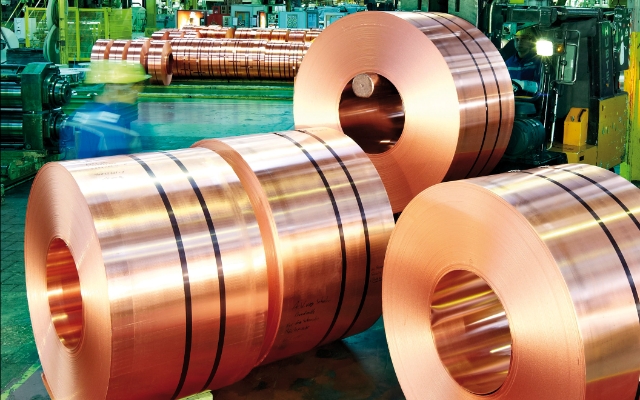The Ultimate Guide to Sustainable Living with Eco-Friendly Copper Products
The Ultimate Guide to Sustainable Living with Eco-Friendly Copper Products
Blog Article
How Copper Products Contribute to Sustainable Practices in Numerous Fields
In eco-friendly power systems, for instance, copper boosts the functionality of solar and wind innovations, while its application in building and construction lessens waste with long life. As industries seek to embrace even more lasting techniques, the duty of copper could verify critical in accomplishing environmental objectives.
Copper in Renewable Power
Copper plays a vital duty in the innovation of renewable power technologies, working as an important conductor in different applications. Its outstanding electrical conductivity and resistance to rust make it an optimal product for electrical circuitry, which is necessary in solar panels, wind turbines, and energy storage space systems. In solar photovoltaic systems, copper is utilized in the affiliations and circuitry, allowing efficient power conversion from sunlight to electricity.
In wind power, copper is important to the generators and transformers that convert kinetic energy into electrical energy, guaranteeing optimal efficiency and reliability. The need for electrical vehicles (EVs) is enhancing, with copper being a key part in batteries, electric motors, and billing facilities. The change to EVs dramatically improves the need for copper, as these lorries generally use four times extra copper than conventional interior combustion engine automobiles.
As the world seeks to mitigate climate adjustment and change to sustainable energy resources, copper's duty ends up being increasingly crucial. The product not only enhances the effectiveness and resilience of eco-friendly energy systems but also sustains the more comprehensive goal of decreasing greenhouse gas emissions and advertising a lasting future.
Eco-Friendly Building And Construction Products
In recent years, there has actually been a significant change towards the fostering of environment-friendly building and construction materials in reaction to expanding environmental problems. This adjustment is encouraged by the demand for sustainable alternatives that reduce eco-friendly impacts while maintaining structural stability and visual charm.
Copper, known for its resilience and recyclability, has actually arised as an essential gamer in this sector. It can be used in roof, pipes, and electric systems, adding to energy effectiveness and reducing waste. Copper's longevity means less substitutes over time, more enhancing its sustainability account.
Additionally, materials such as bamboo, redeemed wood, and reused steel are getting appeal. These options not only offer decreased ecological impact but additionally advertise source conservation. As building codes increasingly highlight sustainability, architects and home builders are incorporating these materials right into their tasks, fostering technology in design.
The boosting adoption of environmentally friendly construction materials mirrors a more comprehensive commitment to sustainability in the constructed environment. By focusing on these products, the construction sector can dramatically minimize its carbon footprint, line up with governing criteria, and support a much healthier ecological community for future generations. This fad marks a pivotal step towards an extra lasting future in building and construction.
Copper's Duty in Health care
Current studies have actually highlighted the considerable role of copper in medical care setups, especially due to its antimicrobial properties. Copper surfaces have actually been shown to decrease the existence of pathogens, consisting of viruses and microorganisms, by as much as 99.9% within a brief duration. This remarkable effectiveness makes copper a very useful product for high-touch surfaces in health centers, such as doorknobs, bed rails, and IV poles, thereby adding to enhanced infection control actions.
Along with its straight antimicrobial results, copper likewise contributes in the more comprehensive context of medical facility sustainability (Copper Products). By incorporating copper right into clinical tools and furnishings, medical care centers can lower the occurrence of healthcare-associated infections (HAIs), which not only boosts patient results yet additionally reduces the prices associated with extensive hospital stays and added therapies
Moreover, copper's toughness and recyclability align with lasting practices, enabling responsible source management. As healthcare systems progressively prioritize both individual safety and ecological stewardship, the integration of copper products is ending up being more common. This dual advantage underscores copper's crucial contribution to a much healthier, safer, and more sustainable medical care setting.
Sustainability in Transport

Moreover, copper's resilience and corrosion resistance add to the durability of transportation framework (Copper Products). In rail systems, for example, copper components enhance the integrity and effectiveness of signaling and power systems, vital for decreasing hold-ups and energy usage. Furthermore, copper's duty in renewable resource systems, such as solar and wind, sustains lasting transport solutions by supplying clean power for electrical transit options
Investments in copper modern technology not just foster sustainability but also stimulate financial development and job development in green fields. As industries aim to satisfy strict environmental guidelines, the application of copper items in transport becomes an essential approach in attaining sustainability goals and promoting a cleaner, much more reliable future.
Copper and Circular Economy
As the world progressively embraces sustainability, the redirected here function of copper in the round economy becomes ever before a lot more substantial. Copper's intrinsic homes-- such as its recyclability, durability, and conductivity-- setting it as a vital material in a resource-efficient economic situation. The circular economy intends to decrease waste and maximize source use with recycling and reusing materials, and copper excels in this respect.
The metal can be reused indefinitely without loss of quality, making it an ideal candidate for lasting techniques across different markets, including building and construction, electronic devices, and renewable resource. By recouping and recycling copper from end-of-life items, industries can substantially minimize the demand for virgin materials, therefore lowering environmental effects connected with mining and processing.
In addition, the assimilation of copper into round economy frameworks not just preserves sources but additionally fosters development. Companies that focus on copper recycling contribute to a much more lasting supply chain, improving their competition while straightening with regulatory needs and consumer choices for eco responsible products.
Verdict
To conclude, copper items substantially Continue add to lasting practices throughout multiple markets. Their vital duty in boosting renewable energy innovations, advertising environment-friendly building and construction products, supporting infection control in healthcare, assisting in sustainable transport, and embodying the concepts of a round economic situation underscores the versatility and importance of copper. By integrating copper right into numerous applications, markets can accomplish higher effectiveness, decrease ecological effect, and align with worldwide sustainability goals, inevitably fostering a more lasting future.

Copper's outstanding conductivity makes it a recommended product in electrical automobile (EV) systems, improving energy effectiveness and performance. In addition, copper's duty in eco-friendly power systems, such as solar and wind, supports lasting transportation services by supplying tidy power for electric transit options.
Their important duty in boosting eco-friendly power modern technologies, promoting environment-friendly Our site building and construction materials, supporting infection control in medical care, assisting in sustainable transportation, and embodying the concepts of a circular economic situation highlights the convenience and relevance of copper.
Report this page